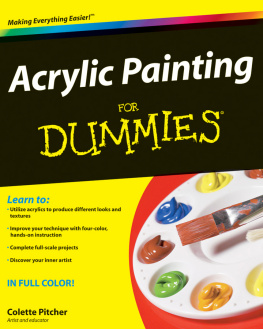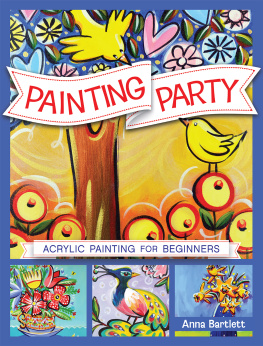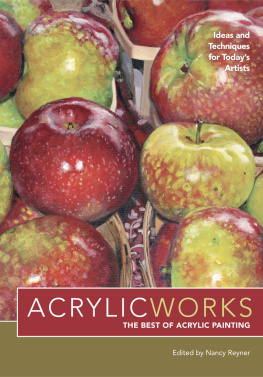DAN TRANBERG
ACRYLIC
FUSION
EXPERIMENTING WITH ALTERNATIVE METHODS FOR PAINTING, COLLAGE, AND MIXED MEDIA

2012 Quarry Books
Text 2012 Dan Tranberg
First published in the United States of America in 2012 by
Quarry Books, a member of
Quayside Publishing Group
100 Cummings Center
Suite 406-L
Beverly, Massachusetts 01915-6101
Telephone: (978) 282-9590
Fax: (978) 283-2742
www.quarrybooks.com
Visit www.Craftside.Typepad.com for a behind-the-scenes peek at our crafty world!
All rights reserved. No part of this book may be reproduced in any form without written permission of the copyright owners. All images in this book have been reproduced with the knowledge and prior consent of the artists concerned, and no responsibility is accepted by the producer, publisher, or printer for any infringement of copyright or otherwise, arising from the contents of this publication. Every effort has been made to ensure that credits accurately comply with information supplied. We apologize for any inaccuracies that may have occurred and will resolve inaccurate or missing information in a subsequent reprinting of the book.
10 9 8 7 6 5 4 3 2 1
Digital edition published in 2014
Digital edition: 978-1-61058-186-8
Softcover edition: 978-1-59253-752-5
Library of Congress Cataloging-in-Publication Data
Tranberg, Dan.
Acrylic fusion : experimenting with alternative methods for painting, collage, and mixed media / Dan Tranberg.
p. cm.
ISBN-13: 978-1-59253-752-5 (pbk.)
ISBN-10: 1-59253-752-9 ()
1. Acrylic paintingTechnique. 2. Decoration and ornament. I. Title.
TT385.T726 2012
751.426--dc23
2011031314
Design: Rita Sowins / Sowins Design
Images: Dan Tranberg
Golden Artist Colors, Inc. is in no way responsible for the contents of this book. The author does not work for Golden. As an artist, the author began using Golden products during the 1990s, and since that time, Golden has become his preferred brand of acrylic paint and media. With minor adjustments, the techniques in this book can be used with any brand of professional artist acrylics.
TO MY PARENTS.
CONTENTS
INTRODUCTION
Since the early 1960s, when acrylic paints formulated specifically for artists first became widely available, the medium of acrylic has grown to include an incredible diversity of products with a range of qualities unlike any other form of paint. In addition to the extensive range of acrylic colors now available, acrylic mediums have exponentially expanded the possible surfaces, textures, and applications now able to be achieved. More than ever, acrylic is a medium of endless possibilities.
This book was conceived as an introduction to the idea of experimenting with nontraditional approaches to acrylic paint. It uses abstract painting as a framework, but the techniques outlined here can be applied to many other outcomes, from journal making to furniture refinishing. It aims to expose some of the vast possibilities that acrylic paint holds, in hopes of sparking ideas, encouraging experimentation, and inspiring artists in many different creative endeavors. Learn more at www.acrylicfusionthebook.com.
The abstract expressionist painter Willem de Kooning once famously said, Flesh is the reason oil paint was developed. So, what about acrylic paint? Just as the development of oil paint in the early fifteenth century changed the way that artists painted the human figure, the development of acrylic paint in the mid-twentieth century radically changed the way that paintings could be made.
No longer tied to the figure, or to realistic visions of the world, many of the artists who first used acrylic paint rejected centuries-old traditions and seized the opportunity to create bold and colorful abstract works that exploited the new mediums unique characteristics. Suddenly, large-scale works could be made relatively quickly; paint could be applied to raw canvas without fear of oil penetrating its fibers; and vast expanses of vivid color could be achieved with newfound ease.
Now, in the twenty-first century, acrylic paint is far more versatile than ever before. Testing the boundaries of its current potential begins with getting to know its many qualities. This introductory chapter outlines some basic information on materials, tools, and supports. Its goal is not so much to create a comprehensive overview of all things acrylic, but rather to set the stage for a process and mind-set of informed experimentation.
WHAT IS ACRYLIC PAINT?
Put simply, all paint is essentially pigment mixed with a bindera fluid that binds the pigment and dries to a form a more-or-less flexible film. The traditional binder for oil paint is linseed oil. For watercolor, its gum arabic. For tempera, its egg yolk. For encaustic, its beeswax. To a very large extent, the characteristics of a binder determine the characteristics of a paint made from it. Gum arabic, for instance, remains water soluble when it dries. Therefore, so does watercolor.
The binder for acrylic paint is an emulsion made from of an acrylic polymer and water, also known as an acrylic dispersion. Because it is synthetic, its characteristics are not so limited. Although one of acrylic paints earliest selling points was that it dries quickly, for instance, Golden now produces a product line of acrylic paints called OPEN, with extended drying times, formulated to mimic the handling properties of oil paint.

The very nature of acrylic paint permits tremendous variation. However, a few characteristics persist: In its wet state, acrylic paint is water soluble; when dry, it is water resistant. These characteristics alone make acrylic paint extremely useful; no other paint offers so much potential for experimentation in the studio. Acrylic can be used for mimicking the subtle washes of watercolor or the thick impastos of oil paint. But it is not only the chameleon of all paints; it also can be used to create an endless variety of surfaces and effects that were never possible before its invention.
Tip:
About student-grade acrylic paints: Student-grade paints have a considerably lower percentage of pure pigment than professional-grade paints. In practice, they can be very frustrating to work with and are generally not worth the savings. A better way to save money is to buy small quantities of professional-grade paints and then extend them as needed with mediums, which are far less expensive than paints.
Acrylic paint is available in a variety of viscosities, ranging from thin and watery (airbrush paint) to thick and bulky (heavy body acrylics). It comes in a number of sheens, from glossy to satin to matte.













